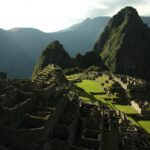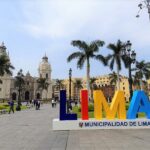Are you looking to travel around Peru in a unique and adventurous way? In this post, I will tell you all about how to get around Peru without taking a plane.
As a Peruvian who has traveled all around her country, I have experienced ways of traveling to which most tourists will not be used. From navigating the Amazon aboard a peque peque to mototaxis in Tarapoto, Peru can be full of adventurous rides.
So, if you are planning a trip to Peru and want to learn more about some unique and alternative means of transport in Peru that don’t involve a flight, keep reading.
Train
Peru has very few railroads, but the few that there are provide great opportunities for exploring Peru by train.
The most famous train ride there is, is the one from the charming Ollantaytambo to Machu Picchu Pueblo (also called Aguas Calientes).
Basically, every tourist visiting Machu Picchu will take this train. So if you are visiting the World Wonder during your trip to Peru, it’s very likely you will as well.
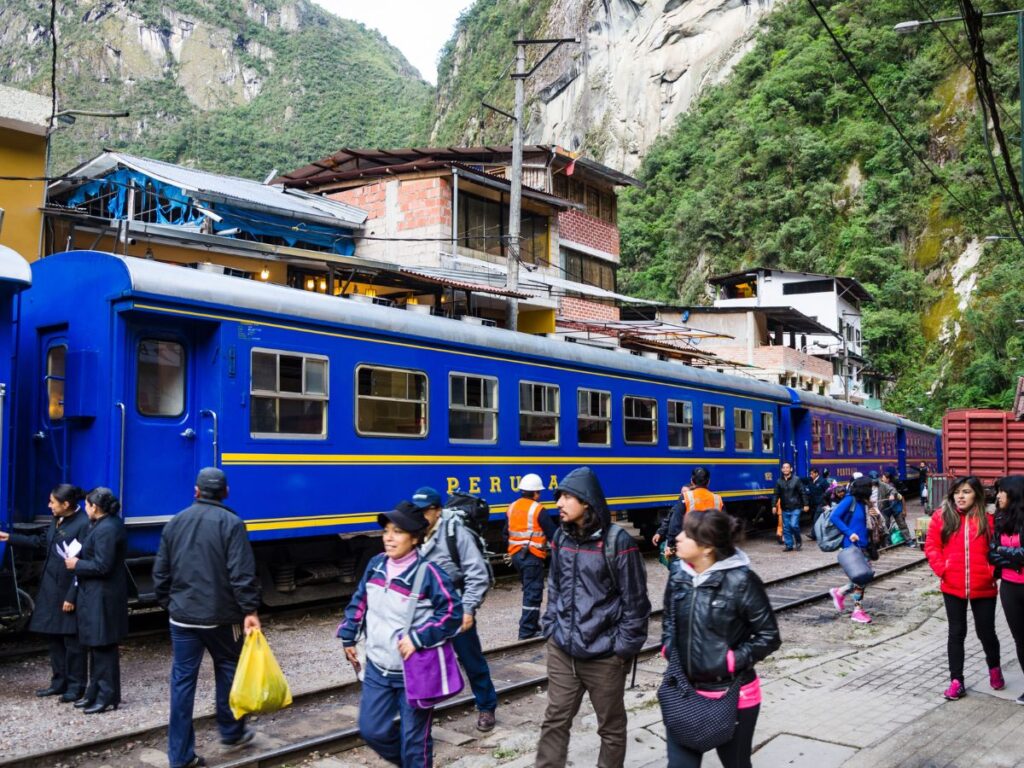
There are several train categories that you can choose from if you want to do that route. From regular tourist ones to the luxurious Hiram Bingham train where you enjoy gourmet food and typical dances during your 2 and a half-hour ride. But all of them will take you among the majestic mountains of the Sacred Valley.
Another famous train is the Andean Explorer, another very luxurious train that covers the routes Cusco-Puno, and Arequipa-Puno-Cusco, and vice versa.
The short route is 1 night long, while the one that includes Arequipa is 2 nights long. These journeys include not just the train rides but also food, cocktails, and touristic visits on the way.
If you don’t have that budget but still want to experience traveling in Peru by train, you have two options.
One of them is the train Lima to Huancayo, which departs from Lima center and takes you along small towns and mining areas on its way to the Andean city. In the journey, you’ll ascend areas of very high altitude, making it the second-highest train ride in the world.
Otherwise, you can take the train traveling between Huancayo and Huancavelica. This ride will be for the more adventurous traveler, as Huancavelica is a very remote region in the Andes. It’s the perfect train ride if you want to go off-the-beaten-path in Peru.
Cable Car
If you travel to the beautiful Chachapoyas, in the north of Peru, you will have the chance to ride the only cable car in Peru.
The ride joins the small city of Chachapoyas and the mystical Kuelap fortress, one of the most important but lesser-known archaeological sites in Peru. Kuelap is actually often referred to as the “Machu Picchu of the North.”

Located on a mountaintop, Kuelap offers breathtaking views of the surrounding cloud forests and verdant landscapes.
The cable car ride is 20 minutes long and is a safe, accessible, and offers a remarkable perspective on both the archaeological site and the jungle below.
It’s not just a convenient and unique means of transport in Peru. It’s an experience that adds an extra layer of wonder to your exploration of the Chachapoyas region.
Mototaxis
In smaller towns and cities throughout Peru, you’ll encounter a distinctive and efficient mode of transportation known as “mototaxis.” You might also know them as “tuktuks.”
These three-wheeled motorcycle taxis are practical and cheap means of getting around in Peru.
Mototaxis are ideal for short trips within a town or city, taking you from your accommodation to markets, restaurants, and local attractions. They might not be the most comfortable option for longer journeys, but they provide an exciting way to explore the local scene.
The main region of Peru where you will find mototaxis is the jungle. These are very common in places like Iquitos, Tarapoto, or Oxapampa.
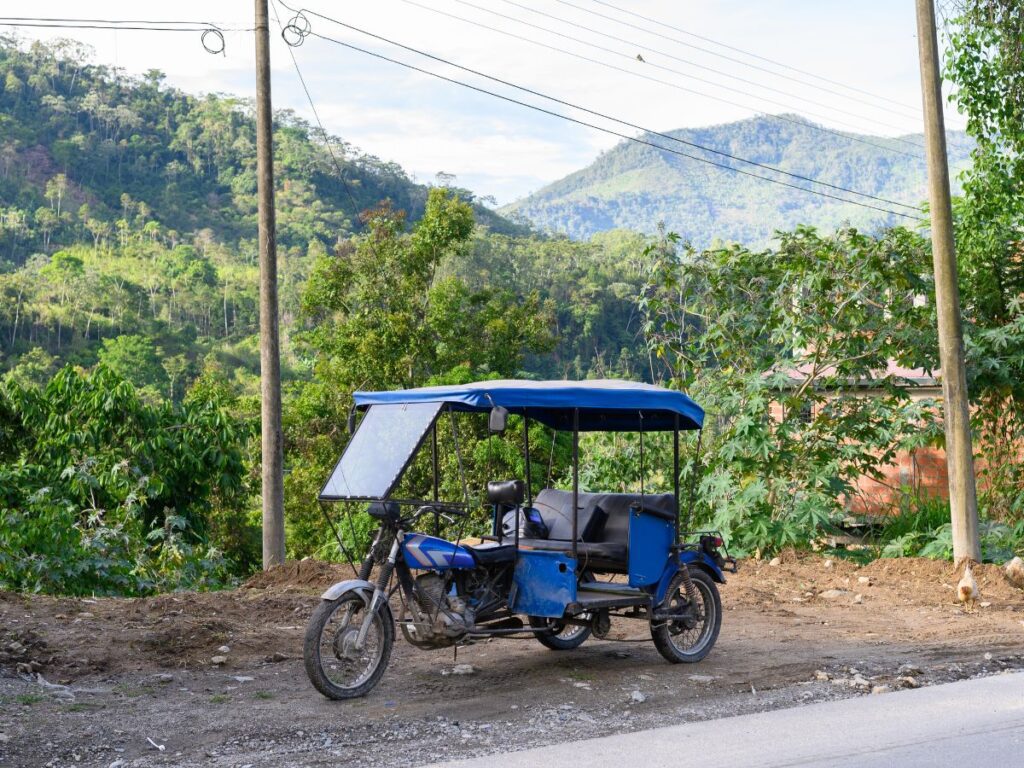
You will also find them in other parts of the country, though they are less common. For example, in some cities and towns in the Andes region, like around the Sacred Valley, Ayacucho, or Huancayo, and on the coast.
Even in Lima, there are mototaxis, though they are not allowed in busy nor residential areas. This means that you will not see them in Miraflores nor in most areas of Barranco.
Peque peque
Peque peques are small and narrow canoes that provide a means of getting around the intricate network of waterways that crisscross the Amazon basin.
It’s an essential means of transport for the jungle communities in Peru, who sometimes have to travel for several hours or days by peque peque to get to a bigger town or city.
In Peru, we have the high jungle and low jungle. The high jungle is the mountainous rainforest, while the low jungle is flat.
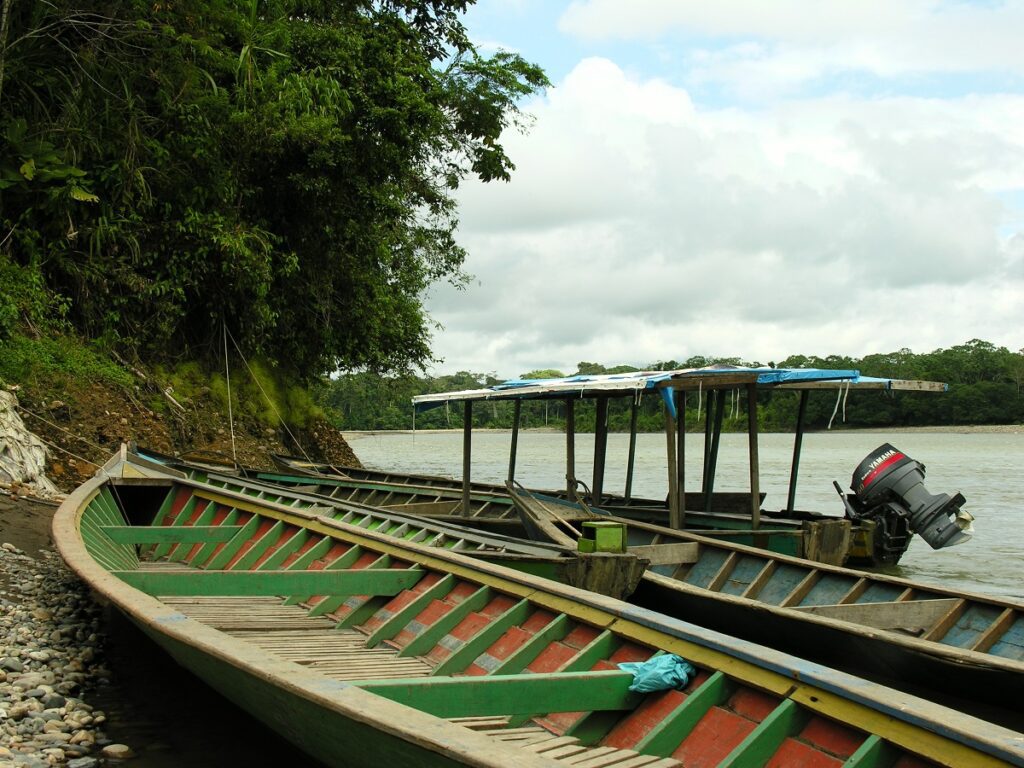
If you are going to be exploring the low jungle of Peru, you’ll possibly find the opportunity to experience a peque peque ride. Examples of low jungle are Iquitos, Tambopata, and the Manu National Park (you can read my misadventures traveling by peque peque to the Manu National Park here).
A typical scenario might involve journeying to a remote jungle lodge, where a peque peque ride is a common mode of transport to reach your destination.
The serene experience of gliding through the water, surrounded by lush vegetation and the sounds of birds and animals, is a magical travel experience.
Boat
Besides the pequepeques, there are, of course, bigger boats that navigate the Amazon river. They offer an incredible opportunity to travel in one of the most biodiverse regions on Earth, where rainforests and winding waterways await.
These larger boats undertake journeys that can last several days. The duration of a specific route will greatly depend on whether you are going upstream or downstream. It will also be influenced by the time of year. For example, during the rainy season in Peru, the rivers will have a higher water flow, reducing the trip duration.
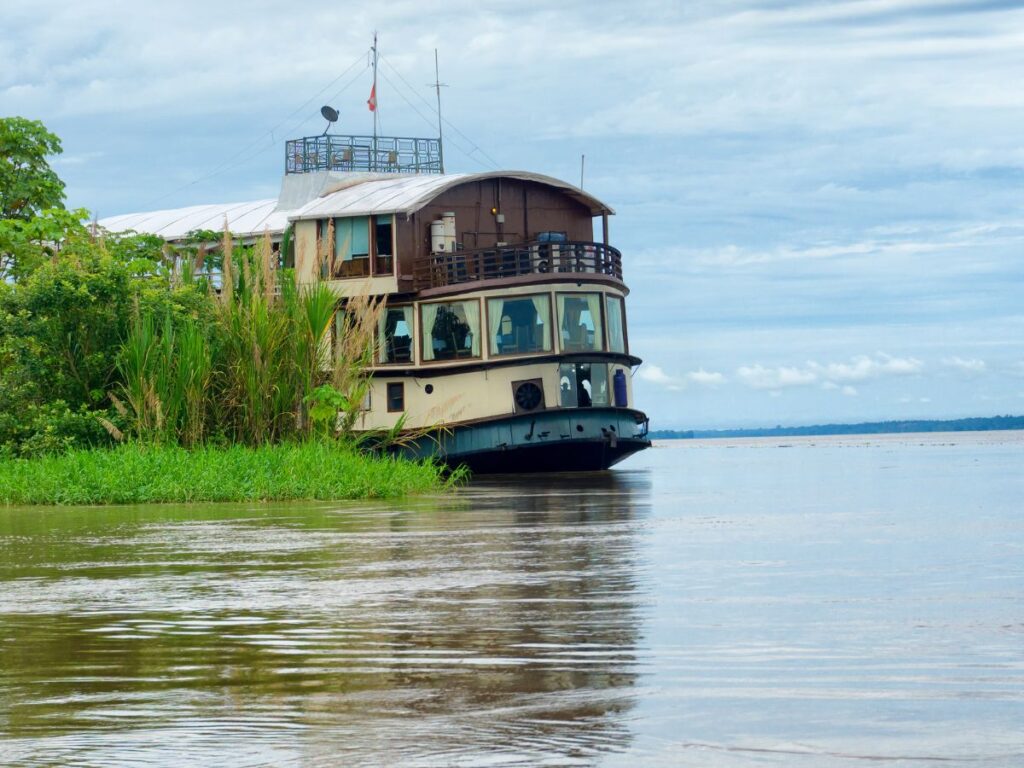
There are both national and international routes that you can travel by boat in Peru.
A popular national route is the one between Pucallpa and Iquitos. It’s a journey that takes an average of 5 or 6 days, traveling through the jungle with over 200 or 300 other people.
If you’re looking to continue your backpacking trip in South America beyond Peru, you can also travel to and from Leticia in Colombia and Manaus and Tabatinga in Brazil.
Depending on the route you take and the class you pay for, you might need to bring your own hammock and hang it wherever you find space onboard. This is the most popular choice for locals, where you will find yourself surrounded by dozens of people, spending lazy days navigating the Amazon.
If you pay a bit more, you will possibly be able to get your own compartment and bathroom.
There’s also a Norwegian ferry that offers a more comfortable trip between Colombia and Peru, which is the most popular choice among backpackers.
Colectivos
If you are looking for an economical and practical way to move between towns and cities in Peru, colectivos, or shared taxis, are the go-to choice. These are taxis shared among passengers traveling along the same route.
They are widely used for short to medium-distance travel and provide a cheaper alternative to traditional taxis.
For example, travelers heading to Machu Picchu on their own will most likely take one of these shared taxis to get to Ollantaytambo, the town from where they have to catch the train to Machu Picchu.
Colectivos are also the most common way to travel between towns in the Sacred Valley. So if you are spending some days in Cusco and not visiting all the attractions as part of organized tours, you will most likely take a colectivo to get from Cusco to the Sacred Valley.
Every city and most towns will have some kind of colectivos in Peru. They are generally a safe alternative if you are in a small town.
If you are in Lima, though, I would not recommend taking a colectivo. Fake colectivos are unfortunately not that uncommon in Lima, and you could end up mugged.
Buses
Buses are the most common way of getting around in Peru. When we talk about buses in Peru, we have two categories: urban buses and interprovincial buses.
Urban buses are the primary means of transport for most Peruvians, and they are a great way to explore the “authentic” Peru. They are cheap, and you can basically hail them at any corner and get off at any corner as well.
However, be ready for the bustling realities of rush hour travel, where buses can get quite crowded, often go at very high speeds, and occasionally make sudden stops.
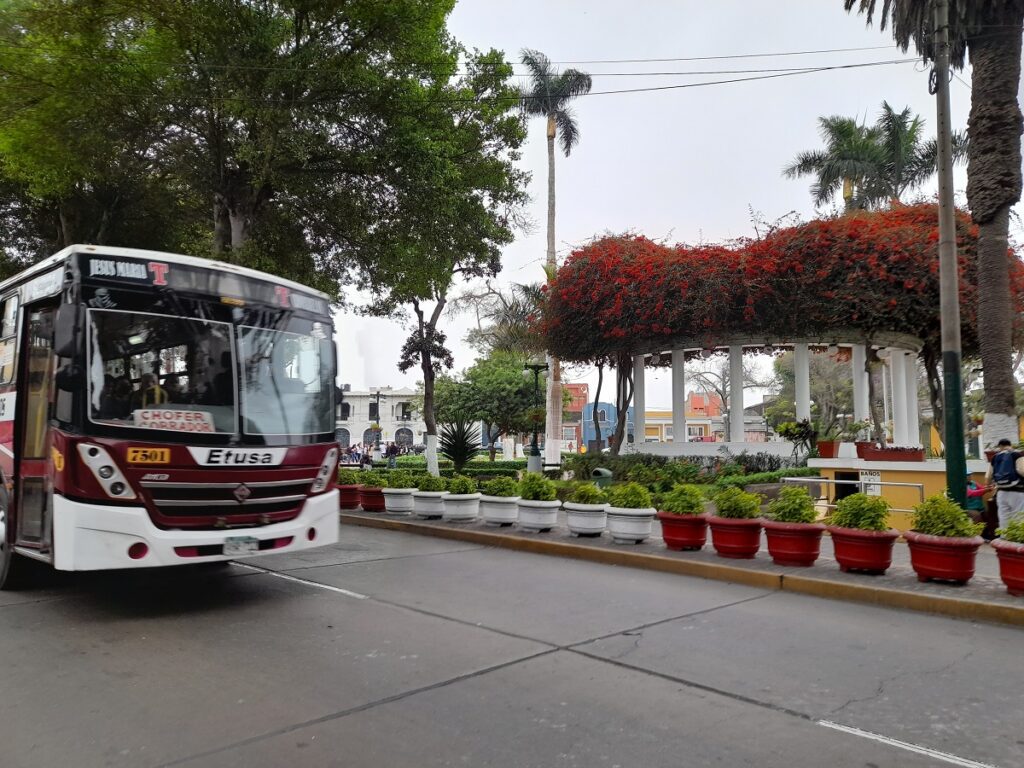
On the other hand, there are interprovincial buses, which are much better than the urban ones. While there are many different categories, from basic to luxury, even an average one should be fine.
As a Peruvian, something that surprises me is how often I hear from foreign friends or acquaintances how impressed they are with this kind of buses in Peru. Most mention that buses are not as good in their own countries.
Depending on your budget, you can choose from standard buses with normal non-reclining seats (these will be the least comfortable), semi-cama (seats that recline a bit), and some companies also offer 160° or 180° VIP reclining seats for overnight journeys.
In some luxury buses, you will also get your own screen and a selection of movies. Prior to Covid, a meal was also included, but most companies still haven’t gone back to offering them. The best companies for this kind of buses are Excluciva and Cruz del Sur.
Micros and Combis
Besides buses, micros and combis are other very popular ways of traveling in the city, although some of them also travel along the highway, stopping at different towns.
Micros and combis are essentially like buses but smaller.
Micros are medium-sized and, in addition to having the same downsides as urban buses, they are cheap and convenient. However, they have an extra disadvantage. They try to fit the maximum number of seats in a limited space. So if you are tall, you might not have enough legroom.
Combis are even smaller than micros. They are minivans where you can’t actually stand. If you are tall, I wouldn’t recommend traveling in one if you have an alternative!
Trekking and Hiking
Peru is very famous for its hiking trails, especially the famous Inca Trail to Machu Picchu. There are different versions of the trail, but a common one lasts for four days, walking around the magnificent Sacred Valley.
While the Inca Trail is the most famous trek in Peru, there are many other beautiful treks. For example, the beautiful Colca Canyon in Arequipa, where you will walk around the second-deepest canyon in the world (one of the best things to do in Arequipa). Or the paths between turquoise lakes and the snow-capped peaks of the Cordillera Blanca if you want to hike in Huaraz.
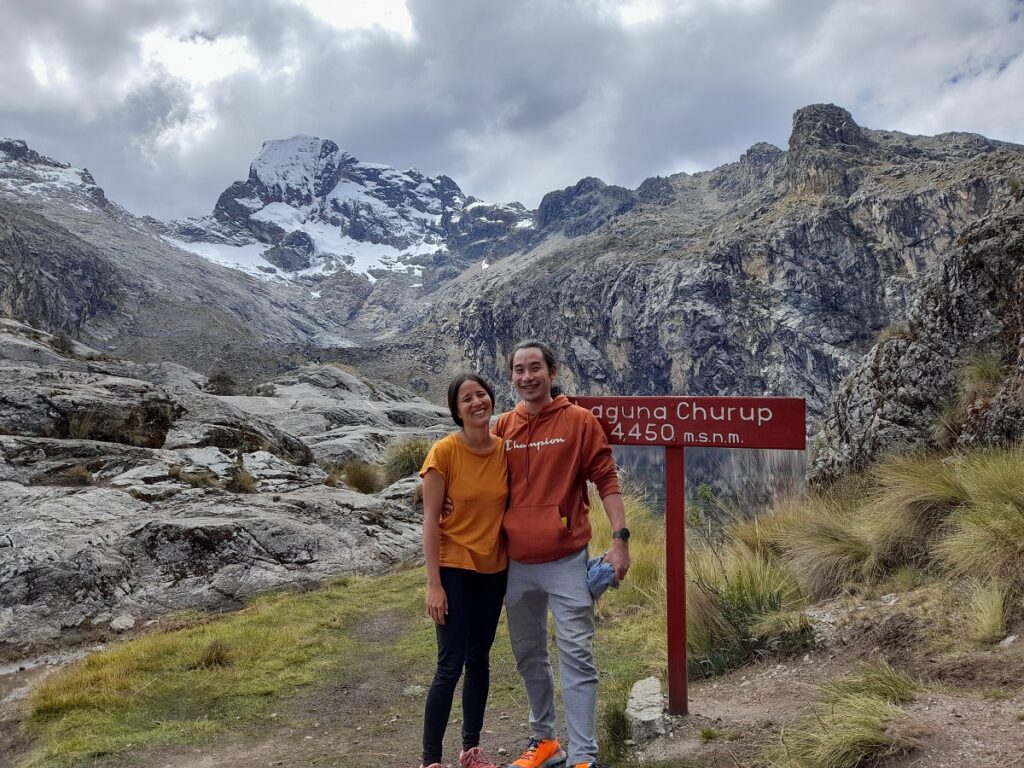
These are just the most famous ones, but Peru has hiking opportunities everywhere. If you are traveling slowly, you will realize that there are beautiful paths all around.
I have walked a lot around Peru and done long hikes everywhere, mostly along “ordinary” paths. Paths that only the villagers take around the mountains, but that are as breathtaking as any of the famous ones. If you are looking for this kind of walk, just ask the locals, and they will point you in the right direction.
I even have a friend who decided he wanted to walk from the coast of Arequipa to the jungle of Cusco and made his route just using maps. It turned out to be an amazing adventure. But of course, don’t venture into unknown routes unless you are a very experienced hiker, especially if you are traveling with someone else; it should be totally safe.
Cycling
If you are seeking to explore Peru and its diverse landscapes on two wheels, cycling is the way to go.
While you can find opportunities both in the Andes and on the coast, if you are not experienced in cycling in the mountains, then Lima is your best option. Lima is mostly flat, and you can rent a bike or go on a cycling tour along the boardwalk.
The most popular route is the one going from Miraflores, the commercial and touristic neighborhood, to Barranco, the artsy and hip area. Even though cycling in Lima is generally not so easy if you are not used to the traffic and the way people drive, there’s a long bike lane overlooking the sea along that route.
If you are looking for something more adventurous, then you can go mountain biking in Cusco. There are several agencies that organize tours where you go biking around the Sacred Valley.
And if you want a more thrilling experience, then you can go downhill mountain biking in Urubamba, a town near the Maras salt mines in the Sacred Valley.
Before you Go…
From hiking ancient Inca trails in the Andes to gliding in the serene peque peques through the Amazon, Peru’s alternative transportation options will immerse you in the heart of this incredible country without the need for taking a plane.
Are you also looking for off-the-beaten-path destinations in Peru? Then read this post about alternative Peruvian destinations to learn about Peru beyond Lima, Cusco, Puno, Arequipa and Huacachina.

